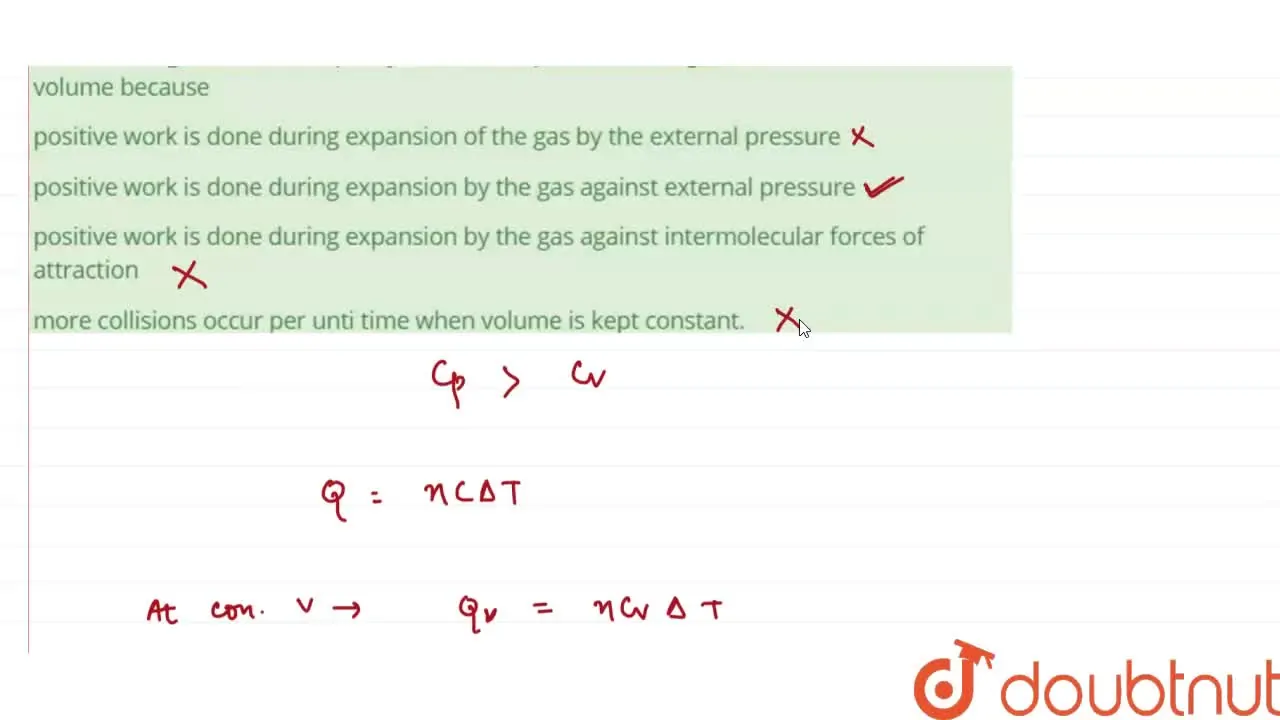For an ideal gas, the heat capacity at constant pressure is larger than than that at constant volume because
positive work is done during expansion of the gas by the external pressure
positive work is done during expansion by the gas against external pressure
positive work is done during expansion by the gas against intermolecular forces of attraction
more collisions occur per unti time when volume is kept constant.
The correct Answer is:B
At constant pressure nCPdT=PdV[by first law of thermodynamics]
At constant volume nCvΔT=ΔU.
∴CP>CV
Related Playlists
- BOOK - RESONANCE ENGLISHCHAPTER - KTG & THERMODYNAMICSEXERCISE - Exercise-21videos
KTG & THERMODYNAMICS
- BOOK - RESONANCE ENGLISHCHAPTER - KTG & THERMODYNAMICSEXERCISE - PART -I15videos
KTG & THERMODYNAMICS
- BOOK - RESONANCE ENGLISHCHAPTER - KTG & THERMODYNAMICSEXERCISE - PART -II17videos
KTG & THERMODYNAMICS
- BOOK - RESONANCE ENGLISHCHAPTER - KINETIC THEORY OF GASES AND THERMODYNAMICSEXERCISE - Exercise64videos
KINETIC THEORY OF GASES AND THERMODYNAMICS
- BOOK - RESONANCE ENGLISHCHAPTER - MAGNETIC FIELD AND FORCESEXERCISE - Exercise64videos
MAGNETIC FIELD AND FORCES
Similar Questions
For a certain gas the heat capcity at constant pressure is greater than that at constant volume by 29.1J/K.
(a) How many moles of the gas are there ?
(b) if the gas is monatomic, what are heat capacities at constant volume and pressure ?
( c) If the gas molecules are diatomic which rotate but do nit vibrate, what are heat capacities at constant volume and at constant pressure.View SolutionThe heat capacity at constant pressure is related to heat capacity at constant volume by the relation
View SolutionFor an ideal gas , the specific heat at constant pressure Cp is greater than the specific heat at constant volume Cv This is because
View SolutionIf an ideal gas is heated at constant pressure :
View SolutionAssetion : Specific heat of a gas at constant pressure is greater than its specific heat at constant volume.
This is because at constant pressure, some heat is spent in expansion of the gas.View SolutionFor an ideal gas, the heat of reaction at constant pressure and constant volume are related as
View SolutionThe molar specific heat at constant pressure of an ideal gas is (7/2R). The ratio of specific heat at constant pressure to that at constant volume is
View SolutionAt a given temperature, the specific heat of a gas at constant pressure is always greater than its specific heat at constant volume.
View SolutionAn ideal gas expands from 100cm3→200cm3 at a constant pressure of 2.0×105 when 50J of heat is supplied to it. Calculate (a) the change in internal energy of the gas , (b) the number of moles in the gas if the initial temperature is 300K , (C ) the molar heat capacity CP at constant pressure and (d) the molar heat capacity Cv at constant volume
View SolutionThe ratio of the molar heat capacities of a diatomic gas at constant pressure to that at constant volume is
View Solution


